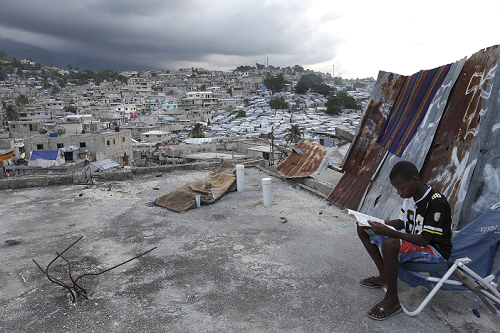High-Level Political Forum Goals in Focus
Goal 11: Make cities and human settlements inclusive, safe, resilient and sustainable
As the world becomes increasingly urbanized, many countries face growing numbers of slum dwellers, worsening air quality and insufficient basic urban services and infrastructure. Urban sprawl continues, with the physical expansion of cities increasing at a rate 1.5 times that of population growth, highlighting the need for better urban planning and more efficient transportation systems. To address many of these challenges, 152 countries have developed national urban policies that support sustainable urbanization. Although progress is being made, efforts must be redoubled to ensure that all urban inhabitants have access to safe and adequate housing, clean air and basic services, and live in resilient and sustainable communities.

Photo Credit : © The World Bank/Dominic Chavez
Urban population growth is outpacing improvements in slum conditions
Over the last 15 years, countries have steadily improved urban slums, managing to move millions of people out of substandard conditions and providing them with adequate housing. As a result, between 2000 and 2014, the proportion of the world’s urban population living in slums declined by 20 per cent (from 28.4 to 22.8 per cent). However, the rate of new home construction lagged far behind the rate of urban population growth, and the number of people living in slums actually increased from 807 million to 883 million over this period. The majority of those living in slums are located in three regions: Eastern and South-Eastern Asia (332 million), Central and Southern Asia (197 million) and sub-Saharan Africa (189 million).
Managing solid waste remains a major environmental challenge in cities in several regions
The safe collection, removal, treatment and disposal of solid waste are among the most critical services in the urban environment. As urban populations grow, income levels rise and economies become more consumer oriented, the volume of solid waste generated will only get larger. Data from 214 cities or municipalities in 103 countries show that about three quarters of municipal solid waste generated is collected. In sub-Saharan Africa, less than half of all municipal solid waste generated is collected, with adverse effects on the health of residents. Moreover, even when waste is collected, it is often not treated and disposed of in a sustainable and environmentally sound manner. Managing such waste continues to be a major challenge facing urban areas in several regions.
Ninety per cent of urban dwellers worldwide are breathing unsafe air, resulting in millions of deaths
Air pollution threatens the health of most city dwellers. In 2016, in all regions except Australia and New Zealand, the annual mean levels of fine particulate matter (PM2.5) exceeded the World Health Organization air quality guidelines of 10 micrograms or less per cubic metre. In the Central and Southern Asia, and the Northern Africa and Western Asia regions, the mean level was more than five times the guideline value. This means that 9 out of 10 people living in urban areas lacked clean air, and more than half of these people were exposed to air pollution levels at least 2.5 times higher than the safe threshold of particulate matter concentration. In 2016, an estimated 4.2 million people died as a result of high levels of ambient air pollution. Air pollution does not recognize borders, and improving air quality demands sustained and coordinated government action at all levels.
More than half of the built-up areas in cities worldwide are public open spaces
Public open spaces in the world’s cities—parks, boulevards, gardens, playgrounds, streets—play a vital role in social and economic life by providing a place where people can interact. The added benefits of such spaces often include cleaner air and increased walkability, which contribute to physical and mental health. Land use planners recommend that 15 to 20 per cent of urban land be allocated to public spaces (excluding streets) and between 30 and 35 per cent to streets. Data from 231 cities show that 59 per cent of their built-up land consists of urbanized open spaces (approximately half of which is occupied by streets). Latin America and the Caribbean and sub-Saharan Africa are the only regions where this proportion is below 50 per cent for the sample of cities included.
Disaster risk reduction measures are urgently needed to strengthen the resilience of the world’s cities
Reported damage to housing attributed to disasters shows a statistically significant rise from 1990 onwards (even when taking into account the observed high degree of year-to-year variance). Meanwhile, the number of deaths from small- to medium-scale disasters has also demonstrated an upward trend over the same period. Low-income households and small businesses are affected more frequently than middle- and high-income households. This is a result of high exposure to hazards, vulnerable conditions and lower coping capacity. To save lives, prevent and reduce losses, and strengthen the resilience of cities, it is essential to promote public and private investments that take disaster risk reduction into consideration. Many countries have developed measures to reduce disaster risk in vulnerable urban areas, including investments in drainage infrastructure in flood-prone areas, risk-informed urban and land use planning, and appropriate building codes and other regulations.
